We now return you to your regularly scheduled blog...
Now that I've got a lot of time on my hands I'm very much enjoying getting back out into London again. As I discovered when travelling extensively, it turns out that when you're not working fourteen hours a day (or even eight for that matter), there's a lot more time for noodling about aimlessly in cafés, galleries and museums, which is a damned fine way to spend your time, at least until the rent comes due. And though I am certainly biased on this score, I still think London is perhaps the best city in the world in which to do this. To that end, I've already drunk 17 gallons of latté, been on a good walking tour, popped into the British Museum, watched a really interesting modern dance piece, and discovered the topic of today's blog: the Horniman Free Museum.
Still, you can't fault a place with such a lovely specimen of a spiny echidna:
The lower level of the museum also has rooms with other exhibitions, some of which are permanent, and some that change regularly. I took a quick spin through an exhibit about body adornment, and through the small room dedicated to the permanent collection of cultural artefacts. By this time my feet were killing me so I didn't bother with the African Worlds room or - wait for it - the Aquarium. Yes, there is apparently a real aquarium with fifteen exhibits showcasing "aquatic environments from around the globe, ranging from the British coastline to Fijian coral reefs. A huge variety of aquatic life can be seen, displaying the massive variation in the body shapes, colours and behaviors of animals in different habitats." I told you there was a odd variety of stuff at the Horniman. (The aquarium seems to be the only bit of the museum that is not free, though at a mere £2.50, or £6.00 for an annual pass, it's not really a stretch even for us slackers without jobs.)
Instead I found my way to the museum café, which turned out to be pretty credible, with proper coffee and hot meals cooked on site (made with local organic produce and blah blah blah) and scones and muffins and such. The best part about the café is that you can take your latté and your blueberry muffin and go sit out in an excellent glass house which is just the thing for an October afternoon when the sun is shining but the temperature is slightly too chilly for al fresco dining.
Fortified and rested, I had just enough time for a quick turn around the gardens. What? I didn't mention that there are also gardens? But of course! There's even quite an excellent view, which I took as compensation for the fact that I cycled over from Brixton, which involved getting up quite a substantial hill that the museum and gardens seems to sit right on top of. Perhaps my first clue should have been that the address is in Forest Hill. Nonetheless, the view was good.
But back to the Horniman Museum, which turned out to be a lovely discovery. Certainly if you're visiting London and have limited time in the city I wouldn't recommend it over, say, the British Museum. Or Westminster Abbey. But if you live nearby and can mange the trip up Forest Hill it's definitely a nice way to spend a day. Where else are you going to find a the stuffed head of Pekinese dog, a selection of Maori tattooing equipment, a sound bite of Benjamin Franklin's Armonium, a formal garden with gazebo, a dissected monkey, an ivory inlaid mandolin and a tank of live jellyfish all in one convenient spot? Nowhere outside London, I'll wager.
God, I love this city.
Now that I've got a lot of time on my hands I'm very much enjoying getting back out into London again. As I discovered when travelling extensively, it turns out that when you're not working fourteen hours a day (or even eight for that matter), there's a lot more time for noodling about aimlessly in cafés, galleries and museums, which is a damned fine way to spend your time, at least until the rent comes due. And though I am certainly biased on this score, I still think London is perhaps the best city in the world in which to do this. To that end, I've already drunk 17 gallons of latté, been on a good walking tour, popped into the British Museum, watched a really interesting modern dance piece, and discovered the topic of today's blog: the Horniman Free Museum.
The outside of the oldest part of the museum, including the excellent clock tower and a nice mosaic.
The Horniman Museum was opened in 1901 to showcase the extensive collection of Frederick John Horniman. Horniman was the wealthy heir to what was then the world's largest tea-trading company, and used his money to travel and amass a collection of some 30,000 items, mostly specimens of the natural world and, oddly, musical instruments. The inscription on the front of the museum reads:
Actually, that may be overstating things a bit; it's not like the whole place was in a time warp. But certainly some parts of the collection are as I've described. For instance, the Natural History Collection layout and the contents are deliciously old-fashioned.
"This building and its contents, being a portion of a gift from Frederick John Horniman MP to the London County Council as representing the people of London, are dedicated to the public forever as a free museum for their recreation, education, and enjoyment."These facts - the building, the era, and the collection - combine to make a museum that has a lot of really good qualities. First, as implied by the inscription, it's free, which was enough to rocket it to the top of my list these days. (It's even got the name "Horniman Free Museum" chiseled in huge stone letters outside the old main entrance, which must vex generations of general managers trying to make ends meet and being forever unable to charge even a penny.) Second, as you can see, it looks like a proper museum that will have weird stuff in it, and cobwebs, and shadowy corners and dusty cases, which is all true. Third, it's got a wide and odd variety of things to look at - where else can you see a stuffed walrus in one room and a Les Paul guitar in another? And finally, many of those things are displayed in a lovely old-fashioned way in dark oak displays with plate glass and hand painted gilded numbers to identify them. It's like a museum that belongs... well... in a museum.
Actually, that may be overstating things a bit; it's not like the whole place was in a time warp. But certainly some parts of the collection are as I've described. For instance, the Natural History Collection layout and the contents are deliciously old-fashioned.
Dim lights, glass cases, wood floors, dead stuff. It made me feel like Nancy Drew was about to dash in and solve the "Mystery of the Shrunken Head" (Note: much lovelier photo here, in the Horniman's own Flickr group)
It's been ages since I've seen so many stuffed dead things in quite such a setting. There were birds and insects and mammals - case after case of them.
And skeletons with tiny little lablels. And dissected specimens splayed out and floating in big glass jars of formaldehyde with their circulatory systems dyed blue. It was all displayed for a purpose of course and it was documented well and I even learned a few things. (For instance, did you know that "Owls fly almost silently because they have a fine fringe on the edge of their feathers which breaks up air currents that would cause a whooshing sound when they flap their wings."? I thought not. Thanks Horniman!) Still, you'd just never see a room like that in a modern museum. Certainly you'd never encounter a display case featuring the stuffed heads of different breeds of domesticated dogs.
See what I mean? CREEP-EEEE.
Still, you can't fault a place with such a lovely specimen of a spiny echidna:
They also had a few duck-billed platypus! (Platypuses? Platypi? Hmmmm...) A representative variety of monotremes is crucial to any good natural history museum, I think.
I suppose partly because it's free, or maybe because it's local, or easy, there were quite a few school groups there the afternoon I went. This substantially decreased the dim and pleasing quieness. Then again, maybe I was in a generous mood because I didn't find them as annoying as I might. I think that's partly because even if some are obviously hoodlums and quite possibly about to pull out a knife or a crack pipe, or both, British kids always wear school uniforms which makes it seem charmingly like they've all just stepped out of a Harry Potter novel and causes me to want to ask if any of them are in Gryffindor. Also, I overheard one boy calling his teacher "Sir", which made me go "Awwww".
Nevertheless the decibel level got a bit high, so I left the Nancy Drew room and wandered across the hall to have a look at a display of the 2011 British Wildlife Photography Awards which was really good, very peaceful, and another example of the surprising variety of stuff to look at in the Horniman. (Aside: each photo was accompanied by a little blurb from the photographer and a note about the equipment used to achieve the shot. On the list of gear for one of the winning photos, among other things, was noted a "gitzo tripod and Wemberley head" which is so clearly totally made up that the photographer obviously should have been disqualified.)
The other thing the Horniman is known for is its collection of musical instruments, which is housed in a room on a lower level. This room was quite a bit more up-to-date than the Natural History Collection and included lots of bits of video and a couple of quite good multi-media areas where you could select images of different instruments and hear what they sound like. This was very popular with tiny kids mostly, I suspect, because there were moving video bits and nice big buttons to press.
A small example of the displays.
My favourite bit in the music room was the video display that showed the inner workings of a factory making brass instruments. Why was this so cool? I'm surprised you ask, because obviously watching how flat brass sheeting gets made into a tuba is inherently cool and fascinating (No, I'm not being ironic. Stop looking at me so pityingly.) How could it NOT be cool to learn that one of the ways they bend the brass tubing without it collapsing is by filling the tube with water, and then freezing it, and then bending the tube? This way, the outer diameter stretches instead of the inner diameter collapsing into an empty space. Clever! (Almost as clever as the gears in the Museé des Arts et Metiers.) (No really, I don't need your pity.)
The lower level of the museum also has rooms with other exhibitions, some of which are permanent, and some that change regularly. I took a quick spin through an exhibit about body adornment, and through the small room dedicated to the permanent collection of cultural artefacts. By this time my feet were killing me so I didn't bother with the African Worlds room or - wait for it - the Aquarium. Yes, there is apparently a real aquarium with fifteen exhibits showcasing "aquatic environments from around the globe, ranging from the British coastline to Fijian coral reefs. A huge variety of aquatic life can be seen, displaying the massive variation in the body shapes, colours and behaviors of animals in different habitats." I told you there was a odd variety of stuff at the Horniman. (The aquarium seems to be the only bit of the museum that is not free, though at a mere £2.50, or £6.00 for an annual pass, it's not really a stretch even for us slackers without jobs.)
Instead I found my way to the museum café, which turned out to be pretty credible, with proper coffee and hot meals cooked on site (made with local organic produce and blah blah blah) and scones and muffins and such. The best part about the café is that you can take your latté and your blueberry muffin and go sit out in an excellent glass house which is just the thing for an October afternoon when the sun is shining but the temperature is slightly too chilly for al fresco dining.
It's like baby Kew Gardens!
That's The Shard. I think it's done now. Those top 20 floors still look unfinished to me, but I'm assured they're meant to be some kind of semi-outdoor terrace/viewing gallery sort of thing. Frankly, I think it just looks like they ran out of glass.
God, I love this city.

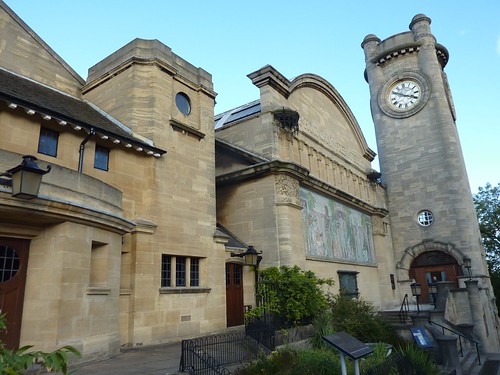


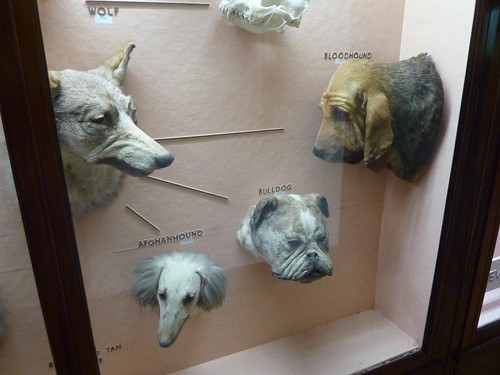
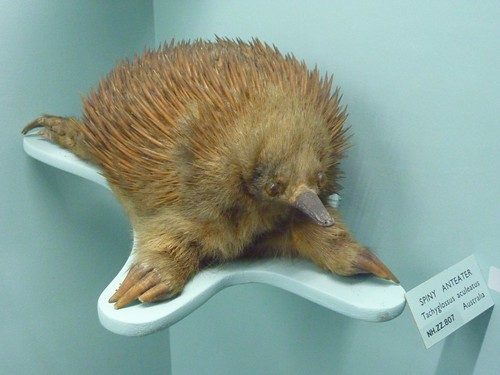
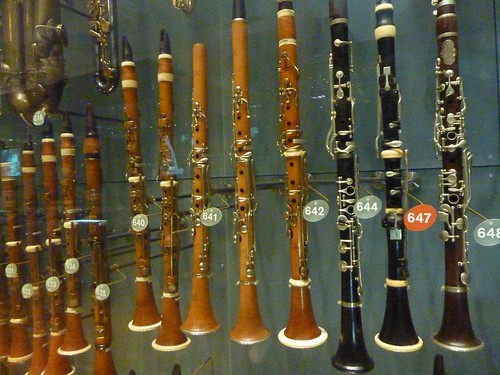
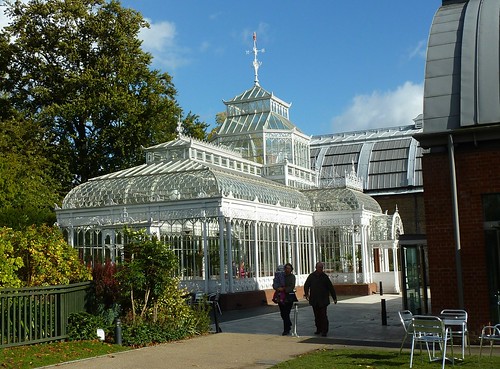
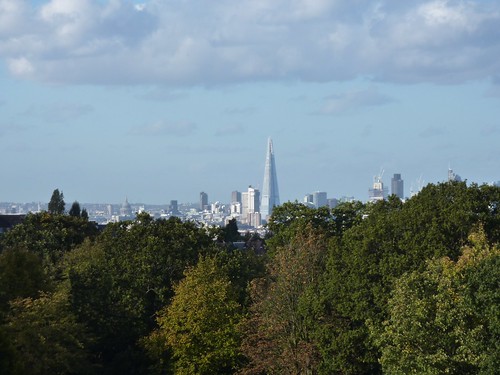


2 Comments:
Bravo! I'm so glad you're back.
On Pam's advice, I went to the Museé des Arts et Metiers in Paris last summer, and it was great. This one is now on my list for my next London visit. rh
Post a Comment